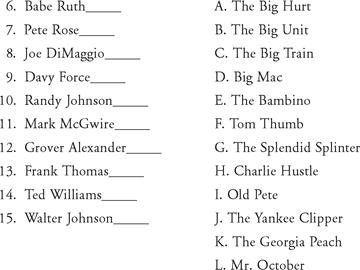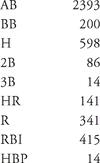Understanding Sabermetrics (35 page)
Read Understanding Sabermetrics Online
Authors: Gabriel B. Costa,Michael R. Huber,John T. Saccoma

Speakers such as these provide a singular opportunity for the students. How can you sit back and listen to Dr. Bobby Brown without learning something about the game? He played baseball with Joe DiMaggio. Need we say more?
(H) Field TripsDue to time constraints and the fact that the course is 1-credit, the students who take MATH 1011 do not presently have the opportunity to make field trips.
Over the years during which MA 488 has been offered, students and instructors have made single-day trips to the following facilities:
• The National Baseball Hall of Fame and Museum in Cooperstown, New York
• The Yogi Berra Museum and Learning Center in Montclair, New Jersey
• The offices of
Mlb.com
in New York City
• Yankee Stadium and the administrative offices of the New York Yankees, located in the Bronx.
We had the added pleasure of meeting Yogi Berra during our visit to his museum. Former baseball commissioner Bart Giamatti once remarked that “talking to Yogi Berra about baseball is like speaking to Homer about the gods.” Our meeting with Mr. Berra verified Dr. Giamatti’s statement.
(I) A Sample of Assessment Instruments: Some Supplemental Problems, Projects, and ExaminationsWith the exception of the first document below, the assessment instruments have been taken from the MA 488 course. We have not included the solutions to these exercises in case some instructors would want to use these for their classes. Should the reader desire solutions to any of the questions below, please e-mail any of the authors.
MATH 1011 — FINAL EXAMINATIONNAME ___________________________________You are allowed to use your notes for this examination. Calculators are permitted.1. Barry Bonds’s 2001 batting statistics:Use the above data to calculate the following quantities: AVG, OBA, SLG, PRO (OB + SLG), ISO, PwrF, RC (not technical), LWTS, and TPQ.2. Fibonacci Win Points is a method to determine the value of a pitcher’s win-loss record. The formula is: (WINS) × (WPCT) + (WINS OVER .500). For example, Yankee Hall of Famer Whitey Ford had a career record of 236 W, 106 L, for a winning percentage (WPCT) of .690. Therefore, FIB = 236 × .690 + 130 = 293.Evaluate the five seasons given below by the above criteria. Also, consider their relative ERAs, their pitching linear weights (PLWTS), and compare their winning percentage to that of their teams. Include an analysis of your results. Whose season was the best?Notes:• PLWTS= (IP/9) × (ERA-League ERA)• Relative ERA = League ERA / Individual ERA3. The following is the career offensive record for Mickey Mantle:Because of injuries, he had less than 10,000 plate appearances (AB + BB). Assuming a 7 percent improvement, find his equivalence coefficient, and use it to project the number of HR he would have had, if his plate appearances had reached 12000.4. Answer as thoroughly as possible:There are many in the baseball community who feel that sabermetrics is not a worthwhile study, while others take the opposite approach. In your own words, describe what impact, if any, sabermetrics has had on your understanding of the game. Explain.
MA488DIAGNOSTIC TEST1. Name a team that played in the first World Series.2. What year was the first World Series?3. Who stroked 257 hits in 1920, setting the seasonal record which lasted over eighty years?4. Who broke the seasonal hit record set in 1920 and how many hits did he amass?5. What is the formula for slugging percentage?Match the players to their nicknames:16. Who was the oldest rookie to play in the Major Leagues: Minnie Minoso, Jackie Robinson or Satchel Paige?17. How many current MLB teams have never won a World Series?18. Who holds the record for the highest lifetime batting average?19. How many different ways can a batter reach first base?20. What is your favorite major league team?KEY: 16-20 correct, All-Star; 11-15 correct, Free Agent; 0-10 correct, Rookie
MA488 PROJECT: PROJECTIONBo Jackson wasn’t the first multisport athlete, but he was one of the best. His feats in both major league baseball and the National Football League are well-known, and the outfielder/running back became the first athlete named to two sports’ All-Star games, a testament to his athletic prowess. After winning the Heisman Trophy and TSN College Football Player of the Year in 1985, Jackson opted to sign with the Kansas City Royals instead of the NFL’s Tampa Bay Buccaneers. He joined the Royals after just 53 games in the minors and, while showing speed and power, he struck out frequently and displayed questionable defense.After showing improvement in 1987 with 22 HR despite 158 strikeouts, Bo announced his plan to play football in the off-season with the Raiders as “a hobby,” a move initially not appreciated by Kansas City players or fans. In 1988 Jackson slammed 25 homers and stole 27 bases but still struck out 146 times. However, in 1989 he finally raised his batting average, to .256, hit 32 HR with 105 RBI, and used his speed and strong arm to become one of the most exciting left fielders in baseball. That same year, Jackson was named to the AL All-Star team, and proceeded to win the MVP Award of the game, after bashing a titanic home run off the Giants’ Rick Reuschel. When the baseball season ended, Jackson returned to the Raiders in full force, and was named to the Pro Bowl just five months after playing the Major League Baseball All-Star game. Bo’s lifetime totals for the following categories are as follows:Using the concept of Equivalence Coefficient (EC), extend Jackson’s total plate appearances to 8,000. Assume that he would decline in performance at a rate of 2.5 percent (as football took a toll on his body). Determine the following:Prior to the recent power explosion, 500 career home runs was almost a guarantee for that player to get into the Baseball Hall of Fame. What EC would Bo Jackson have to maintain to project his home run total to that milestone?References“Bo Jackson.”
BaseballLibrary.com
.
http://www.baseballlibrary.com/baseballlibrary/ballplayers/J/Jackson_Bo.stm
.Retrosheet.
http://www.retrosheet.org
.
MA488 PROJECT: MODELING A “GOOD” PITCHERWhat are the traits of a good pitcher? Control, durability, determination, power, the ability to induce a double play, or the ability to get a strikeout.The Baseball Archive (
http://www.baseball1.com/statistics
) provides pitching data for over 100 years.1. Use the data for 2004 to develop a model that predicts the number of wins per games started. You must decide which data to include. Consider normalizing your data; for example, use hits per inning.2. Use the data for 2004 to develop a model that predicts the effectiveness of closers.3. Compare your models to models that you develop in two other eras.4. Use these models to discuss how pitching has changed.5. Use your models to select a staff of 5 starters and 2 closers using the 2006 data.
Other books
The Devil You Know by Jo Goodman
Whats-In-A-Name by Roxie Rivera
Becoming a Jett Girl (The Bourbon Series) by Meghan Quinn
Hold The Dark: A Markhat story by Frank Tuttle
Troy Rising 1 - Live Free or Die by Ringo, John
JAXON (The Caine Brothers Book 4) by Margaret Madigan
The Tale of Cuckoo Brow Wood by Albert, Susan Wittig
Web of Deceit by Katherine Howell
Darkspell by Katharine Kerr
Bad Blood by Aline Templeton





